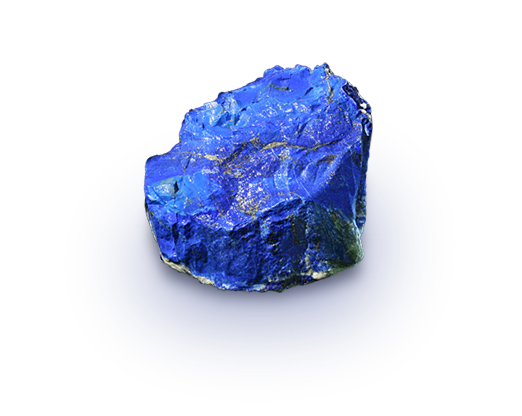OVERVIEW
This ancient rock is an aggregate of several minerals. The three major minerals that comprise lapis are lazurite, calcite, and pyrite. The rock can also contain lesser amounts of diopside, amphibole, feldspar, or mica. Lazurite is the ingredient responsible for producing the gem’s most prized color—bright royal blue.
Lapis lazuli is a rock, which means it’s an aggregate of several minerals. This ancient gem contains three minerals in varying amounts: lazurite, calcite, and pyrite. Sometimes, it also contains one or more of the following: diopside, amphibole, feldspar, and mica.
Lapis frequently contains varying amounts of whitish calcite matrix—the host rock that surrounds the gem—or flecks or veins of glinting yellow pyrite, or both. The gem can also have a smoothly uniform bodycolor, free of visible pyrite and calcite.
- Mineral: Rock
- Chemical composition: An aggregate
- Color: Greenish blue to violetish blue
- Refractive index: 1.500, sometimes 1.670
- Birefringence: None
- Specific gravity: 2.75 (+/- 0.25)
BIRTHSTONE
LAPIS LAZULI isn’t a birthstone
HISTORY
Historians believe the link between humans and lapis lazuli stretches back more than 6,500 years. The gem was treasured by the ancient civilizations of Mesopotamia, Egypt, China, Greece, and Rome. They valued it for its vivid, exquisite color, and prized it as much as they prized other blue gems like sapphire and turquoise.
Badakshan, a province in present-day Afghanistan, is a forbidding wasteland of mountains, bare of any vegetation. The sheer mountain faces rise as high as 17,000 feet, and are scored with treacherous ravines. Humans make their way there to seek one thing only: the azure treasure that is fine lapis lazuli.
The same was true as far back as 700 BC, when the region was part of a country known as Bactria. The lapis mines that were producing then are still producing today. They are, in fact, the world’s oldest known commercial gemstone sources.
Merchant caravans transported their precious blue cargo across Bactria, on their way to the great cities of the ancient Greeks, Indians, Egyptians, Mesopotamians, and Persians. Marco Polo referred to the area’s lapis mines in 1271, but few outsiders have seen them because of their inhospitable location.
For thousands of years, lapis has been fashioned to show off its rich, dark color. Typically, lapis used in jewelry has been cut into cabochons, beads, inlays, and tablets. But lapis lazuli’s use has never been limited to jewelry alone. It’s also a popular carving material. Throughout its history, lapis has been fashioned into practical objects, including game boards, bowls, dagger handles, hair combs, and amulets.
Source of Content : www.gia.edu


